Each day, we:
- Track the status of reopening in all 50 states.
- Compare the status of one industry or activity across the country.
- Provide in-depth summaries of the latest reopening plans.
- Give you the latest stories on other reopening plans and ideas.
Want to know what happened Friday? Click here.
The next two days
What is reopening in the next two days?
June 23:
- New York (Democratic trifecta): On June 22, Gov. Andrew Cuomo (D) announced that the Mid-Hudson region could move into Phase 3 of his reopening plan on June 23. It is the eighth of 10 regions to enter that phase. The Long Island region is on track to enter Phase 3 on June 24. New York City is entering Phase 2 of the plan on June 22, the last region in the state to do so. Phase 2 allows outdoor dining at bars and restaurants (50% capacity), the opening of hair salons and barbershops (50% capacity), and office-based jobs (50% capacity). New York City playgrounds also reopened on June 22.
Since our last edition
What is open in each state? For a continually updated article on reopening status in all 50 states, click here. For our last edition, click here.
- Illinois (Democratic trifecta): Gov. J.B. Pritzker announced the state was on track to enter the fourth phase of reopening starting June 26. Phase 4 will allow gatherings of up to 50 people. Indoor recreation venues (like bowling alleys and theaters), indoor dining services, and outdoor spectator sports facilities will be able to reopen with limits.
- Maryland (divided government): On June 19, Gov. Larry Hogan (R) announced that nursing home facilities could begin offering limited outdoor visits, provided that the facilities are not experiencing an ongoing COVID-19 outbreak and have not recorded a facility-onset case of COVID-19 within the last 14 days.
- Massachusetts (divided government): Effective June 22, Massachusetts moves into the second step of Phase 2 of its reopening. The following are allowed to reopen: indoor table service at restaurants; close-contact personal services (nail salons, tattoo parlors, etc.); retail dressing rooms (by appointment only); and office spaces (50% capacity).
- Nebraska (Republican trifecta): Eighty-nine of 93 counties entered Phase 3 of Gov. Pete Ricketts (R) reopening plan on June 22. The following businesses and activities resumed: bars and restaurants (100% occupancy with social distancing measures); gyms and fitness facilities (75% occupancy); personal care services (75% occupancy); wedding and funeral receptions. Under Phase 3, indoor gatherings are limited to 50% occupancy with no more than 10,000 people, and outdoor gatherings are limited to 75% occupancy with no more than 10,000 people. Childcare facilities reopened with limits that vary by the age of children.
- The remaining counties— Dakota, Hall, Hamilton, and Merrick—entered Phase 2 on June 22. Under that phase, bars and strip clubs may reopen at 50% capacity, host parties up to six people, and patrons are required to stay six feet away from entertainers. Games, such as darts and pool, are prohibited. Gatherings of up to 25 or 25% capacity (excluding staff) for indoor or outdoor attractions are allowed in Phase 2. For larger venues, no more than 3,000 people are allowed, even if that number is less than 25% occupancy. Weddings and funerals can also resume, limited to up to 25 people or 50% occupancy, excluding staff. Phase 2 allows limited, noncontact sports, such as baseball and softball, to resume practices. Games are allowed to resume on June 18. Basketball, tackle football, soccer, and wrestling remain prohibited in Phase 2.
- New Jersey (Democratic trifecta): On June 22, modified, no contact practices for medium contact sports like baseball and high contact sports like football, public and private pools, and personal care services such as hair salons resumed. Outdoor gathering limits increased from 100 to 250 people, so long as six feet of social distance can be maintained. Protests and religious gatherings are exempt from limits on gatherings. On June 22, Gov. Phil Murphy (D) announced that indoor dining and casinos can reopen on July 2, both at 25% capacity.
- North Carolina (divided government): Gov. Roy Cooper (D) vetoed House Bill 594 on June 19. The bill would have allowed gyms and fitness centers to reopen immediately—in advance of Cooper’s reopening plan. Bars would also have been able to open outdoor service spaces at 50% of the venue’s indoor capacity. Cooper said, “Tying the hands of public health officials in times of pandemic is dangerous, especially when case counts and hospitalizations are rising. State and local officials must be able to take swift action during the COVID-19 emergency to prevent a surge of patients from overwhelming hospitals and endangering the lives of North Carolinians. The bill could restrict leaders who need to respond quickly to outbreaks and protect public health and safety.”
- This is the second time Cooper has vetoed legislation seeking to lift restrictions ahead of his reopening plan. On June 5, Cooper vetoed House Bill 536, which would have allowed certain establishments to offer outdoor dining and beverage service.
- A third bill, Senate Bill 599, won legislative approval on June 18. It would allow skating rinks and bowling alleys to reopen at 50% capacity immediately, and before they would have reopened under Cooper’s plan. SB599 was sent to Cooper for consideration on June 22.
- Ohio (Republican trifecta): Contact practice for all sports, including football and lacrosse, resumed on June 22.
- South Dakota (Republican trifecta): The South Dakota Department of Health released a three-phase reopening plan for long-term care facilities, which have been closed since March. In phase one, outdoor visitation is generally permitted, while indoor visitation generally is not. To move from one phase to the next, nursing homes must engage in weekly randomized testing of staff and patients, and there must be no confirmed cases in the facility within the last 14 days.
- Utah (Republican trifecta): On June 19, Gov. Gary Herbert (R) approved nine counties to move into the Green phase of Utah’s reopening plan. Green is the least restrictive phase of Utah’s color-coded reopening plan. To date, ten counties have advanced to the Green Phase. Nineteen counties are currently in the Yellow phase, the second phase in the plan. Only Salt Lake City is in the first and most restrictive phase.
- Wisconsin (divided government): On June 22, the Wisconsin Department of Public Instruction released reopening guidance for schools. Superintendent Carolyn Stanford Taylor said schools would reopen to in-person instruction for the fall. The guidance outlined several scenarios for physical distancing, including four-day school weeks, a two-day rotation, an a/b week rotation, and virtual learning.
Update on stay-at-home orders
Forty-three states issued orders directing residents to stay home except for essential activities and the closure or curtailment of businesses each state deemed nonessential. Seven states did not.
As of June 22, stay-at-home orders have ended in 39 states. Nineteen of those states have Republican governors and 20 have Democratic governors (including Wisconsin, where the state Supreme Court invalidated the stay-at-home order).
The four states with active stay-at-home orders have Democratic governors. They are (with expiration date):
- New York (June 27)
- New Mexico (June 30)
- California (no set expiration date)
- Kentucky (no set expiration date)
Here’s which stay-at-home orders have expired.
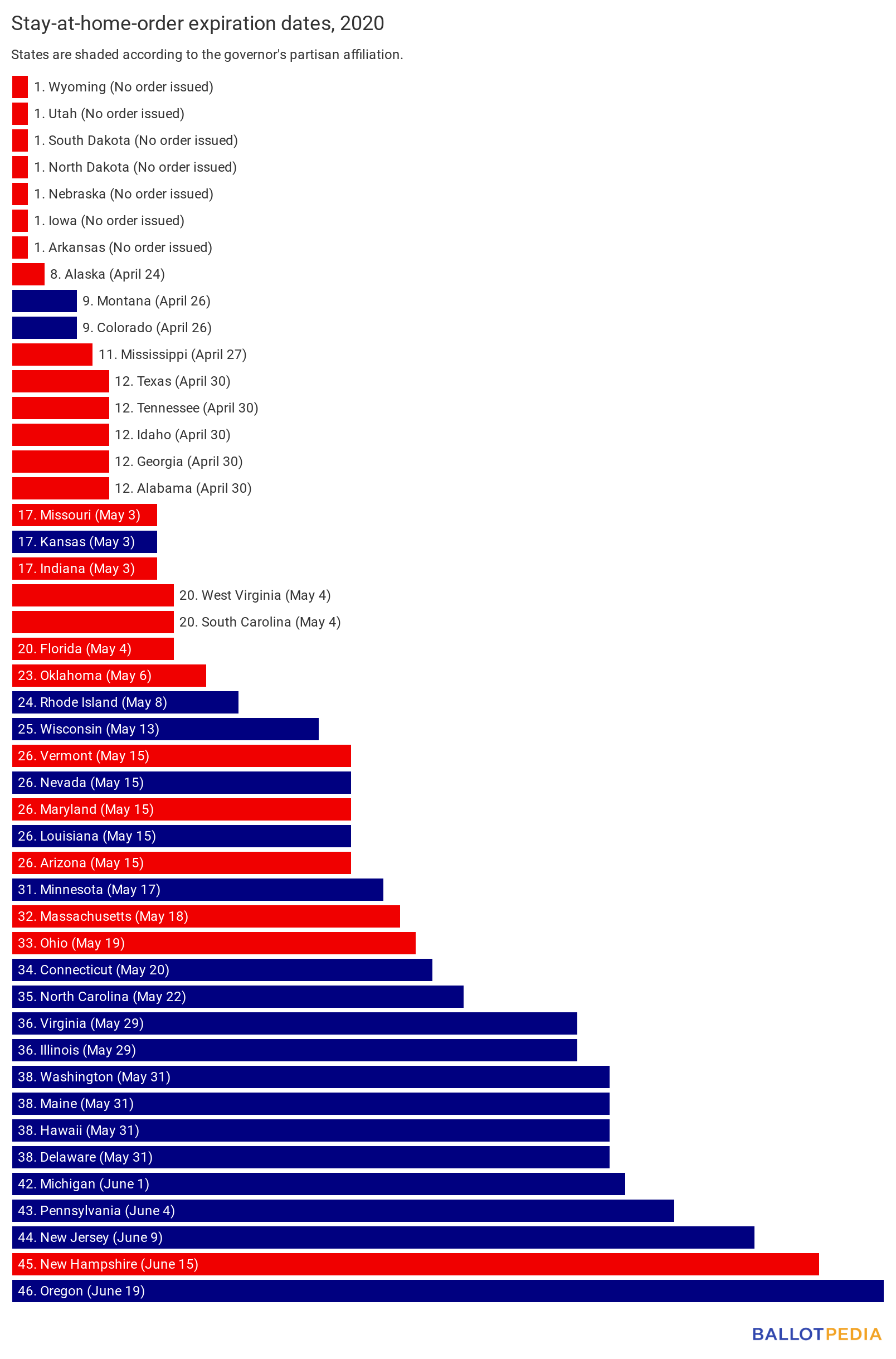
Tracking industries: State face covering requirements
All 50 states began to reopen in some way. Here, we give the status of one industry or activity across the states. Today’s question: in which states must you wear a face covering in public?
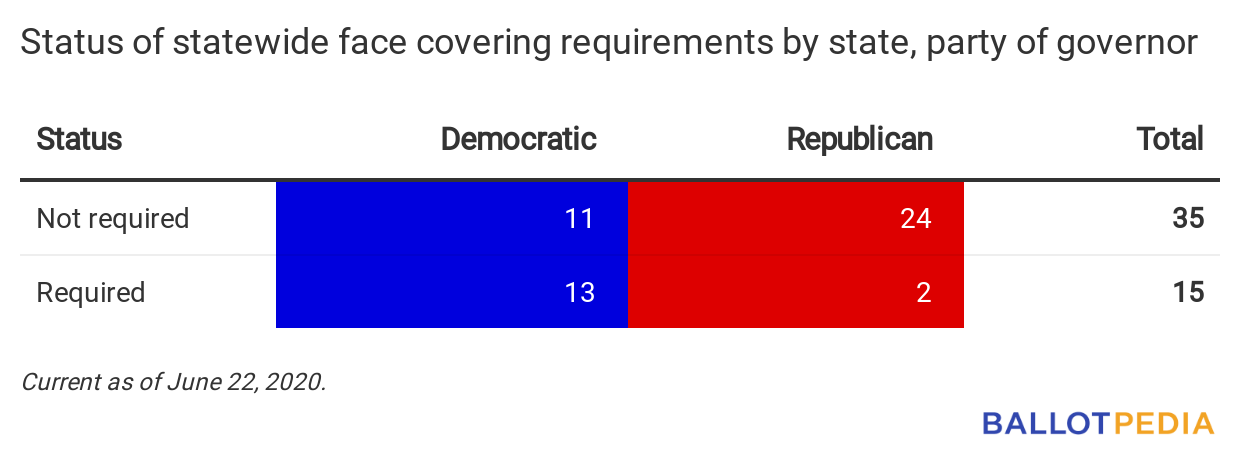 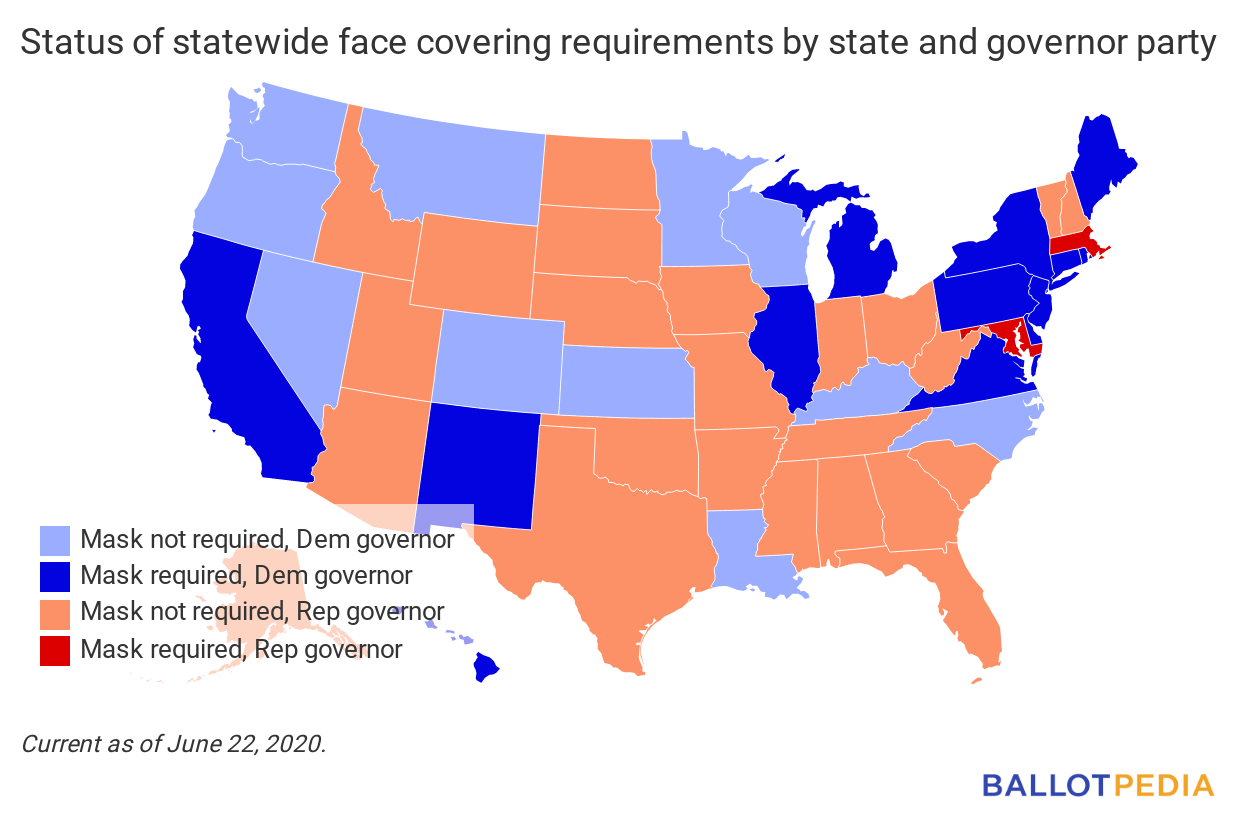
|
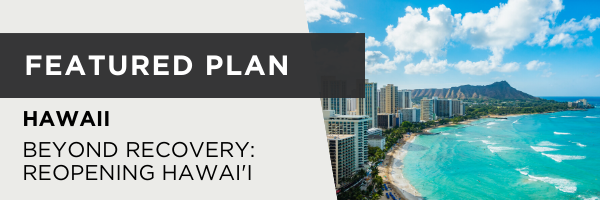
This is an in-depth summary of one of the latest reopening plans. Is there a plan you’d like us to feature? Reply to this email and let us know. Click a state below to read a previous Featured Plan.
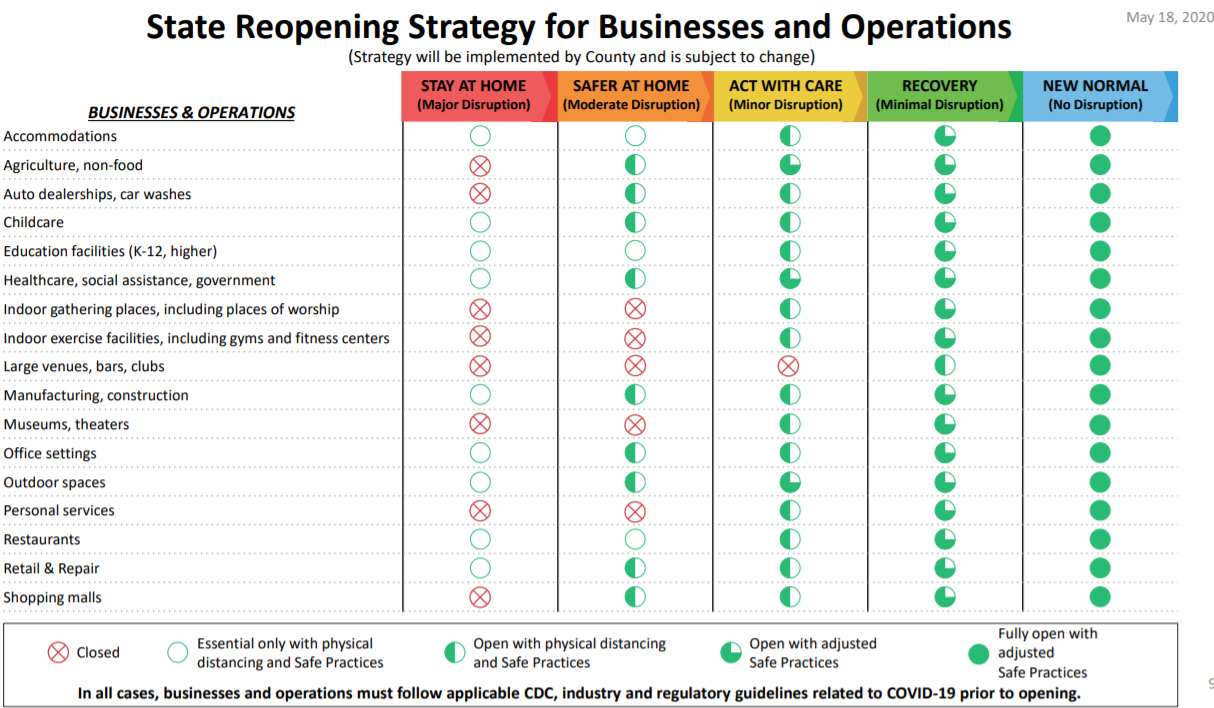
On May 18, Hawaii Gov. David Ige (D) released a four-phased reopening plan, “Beyond Recovery: Reopening Hawai’i.” The phases correspond to varying levels of disruption to daily life. The state entered Phase 1, corresponding with the “Safer at Home” disruption level, on May 7.
Ige said on May 18, “Together, we took public health measures seriously and we flattened the curve in Hawaiʻi. Through our Safe Practices like handwashing, physical distancing, wearing face coverings, and staying home when sick, we achieved safe results. Because of this, we are now seeing a consistent downward trajectory of new cases, a 90% recovery rate, and our hospitals that were once bracing for the worst have significant surge capacity. We also have the lowest fatality rate in the United States.”
Counties must seek approval from the governor before reopening businesses and resuming activities. Reopening timelines have varied by county.
All counties have entered Phase 2, corresponding with the “Act with Care” disruption level. In this phase, most businesses can open with physical distancing and safety restrictions. Large venues, bars, and clubs may reopen in Phase 3.
The governor said there would be a minimum of 14 days between each phase. The plan includes public health criteria that must be met before each transition.
Context
- Ige signed a stay-at-home order that took effect on March 25 requiring residents to stay home except for essential activities and essential business operations. It also established social distancing requirements in public places. The order was set to expire on April 30. Ige issued subsequent orders extending stay-at-home provisions until May 31, with modifications to allow some businesses and activities to reopen or resume on May 7. Customers of businesses and employees who interact with the public or come into contact with goods sold must wear face coverings.
- As of June 20, Hawaii had 814 COVID-19 cases and 17 deaths. Hawaii’s estimated population as of July 2019 was 1.4 million. For every 100,000 residents, Hawaii had 57.5 cases and 1.2 deaths. According to The New York Times‘ analysis, Hawaii had the lowest per capita case rate and among the lowest death rates of any state.
- Hawaii is a Democratic trifecta, with a Democratic governor and Democratic majorities in both chambers of the state legislature.
Plan details
Phase 1: Stabilization
Criteria
“The ‘Safer a Home’ impact level indicates that new COVID-19 cases may occur, but the overall trend is decreasing. During this impact level, Hawaii’s healthcare system is near maximum capacity for testing, hospital capacity, and/or contact tracing. This impact level means that businesses identified as low-risk begin to reopen and a mandatory 14-day quarantine for out-of-state and interisland travelers remains in place.”
See page 17 here for more specific criteria.
Social/individual
- High-risk and elderly recommended to stay home
- No gatherings over 10 people, and maintain at least 6 feet physical distance
Businesses
The following could reopen as part of Phase 1. See the safer-at-home order for social distancing requirements, sector-specific requirements, and county-specific exceptions. The Hawaii Department of Health’s Phase 1 reopening requirements are here.
- Non-food agriculture, i.e., landscape, ornamental plant growers, nurseries
- Auto dealerships
- Car washes
- Pet grooming services
- Observatories and support facilities
- Retail and repair services, i.e., apparel, florists, watch repair, surfboard repair (no fitting rooms)
- Shopping malls, limited to retail and repair services
Phase 2: Reopening
Criteria
“The ‘Act with Care’ impact level anticipates some new COVID-19 cases, which are manageable, along with improved capacity utilization for testing, hospitals, contact tracing. This impact level means that businesses identified as medium to high-risk begin to reopen and there is consideration for lifting the mandatory 14-day quarantine for interisland travelers.”
See page 17 here for more specific criteria.
Social/individual
- High-risk and elderly recommended to stay home
- No gatherings over 10 people, and maintain at least 6 feet physical distance
Businesses/activities
- Accommodations
- Educational facilities
- Indoor gatherings (i.e., places of worship)
- Gyms/fitness centers
- Museums and theaters
- Personal services ( i.e., barbershops, salons, tattoo parlors)
Statewide reopenings/changes
June 8
June 16
- 14-day self-quarantine lifted for inter-island travelers
Phase 3: Long-term recovery
Criteria
“The ‘Recovery’ impact level occurs when new COVID-19 cases indicate sporadic activity and optimized capacity utilization for testing, hospitals, and contact tracing. This impact level means that businesses identified as highest-risk begin to reopen and there is consideration for lifting the mandatory 14-day quarantine for out-of-state travelers”
See page 17 here for more specific criteria.
Social/individual
- High-risk and elderly recommended to stay home
- No gatherings over 50 people, and maintain at least 6 feet physical distance
Businesses
- Large venues, bars, and clubs
Phase 4: Resilience
Criteria
“The ‘New Normal’ impact level means that Hawaiʻi has adjusted to living safely with COVID-19 through a potential combination of effective treatments and containment methods, natural ‘herd immunity,’ and/or vaccines.”
See page 17 here for more specific criteria.
Social/individual
- High-risk and elderly exercise caution in public
- Maintain at least 6 feet physical distance at gatherings
Businesses
- “Fully open with adjusted Safe Practices”
Reopening timelines by county
Timelines for reopenings beyond Phase 1 by county are below.
Hawaii County
May 30 reopening
June 1 reopenings
- Indoor gathering places, i.e., bowling alleys, billiards halls, but not arcades or gaming places
- Fitness centers and indoor pools
- Museums and theaters
- Outdoor spaces, i.e., ocean tours, outside pools, and summer camps
- Personal services, i.e., barbershops, tattoo parlors, and acupuncturists
- Real estate services, i.e., open houses and property viewing
- Other retail and repair, i.e., rental of recreational and sports equipment
- “Certain county park sites and recreational facilities will re-open with some exceptions. County swimming pools, gymnasiums and community centers will remain closed at this time.”
- Restaurants
Honolulu County
May 23 reopening
May 28 reopening
- Outdoor attractions, i.e., water parks, pools, campgrounds
May 29 reopening
- Personal services, i.e., barbershops, nail salons, tattoo parlors
June 5 reopening
- Restaurants
- Other business/commercial businesses
- Indoor residential, non-commercial gatherings of 10 or less (regardless of household)
June 19 reopenings
- Education and care facilities
- Indoor attractions, i.e., bowling alleys, arcades, museums, theatres
- Outdoor organized team sports (two phases, with phase 1 beginning June 19)
- Fitness facilities
- Bars
Kauai County
May 22 reopenings
- Public and private pools
- Places of worship
- Outdoor tour activities
- Salons and barbershops
- All cleaning and construction work
- One-on-one personal services, i.e., fitness, tutoring, music lessons
June 1 reopenings
- Indoor exercise and recreation facilities, i.e., gyms, fitness centers, recreation facilities
- Outdoor spaces, i.e., playgrounds, skateparks, pavilions
- Personal services, including spas
- Restaurants
June 16 reopenings
- Certain accommodations
- Bars and bar top services
Maui County
June 1 reopenings
- Restaurants
- Fitness and recreational facilities
- Personal services, i.e., tattoo parlors, aestheticians, massage therapists
- Playgrounds and skate parks
- Some county pools
County-level business guidance
The following counties released business guidance.
Additional activity
In this section, we feature examples of activities by other federal, state, and local governments and influencers relevant to recovering from the pandemic.
- On June 19, the Phoenix City Council voted to require face coverings while in public. The rule took effect at 6 a.m. on June 20. The vote came after Gov. Doug Ducey (R) said that city and county governments could enact their own health and safety measures for responding to the coronavirus pandemic.
- The Professional Golfers’ Association of America (PGA) announced plans to hold the PGA Championship at TPC Harding Park in San Francisco in August without fans in attendance.
- Central District Health in Idaho announced that Ada County would return to Phase 3 of Idaho’s reopening plan on Wednesday, June 24. Bars and large venues will once again have to close, and gatherings will be limited to 50 people. Ada County is the most populous county in Idaho, containing Boise, the state’s capital.
- On June 16, a group of eight Connecticut landlords sued Gov. Ned Lamont (D) in the U.S. District Court for the District of Connecticut, seeking to block two executive orders issued in response to the COVID-19 pandemic. Executive Order 7G, issued on March 19, suspends non-critical court operations. Executive Order 7X, issued on April 10, prohibits landlords from initiating new evictions through July 1, provides an automatic 60-day grace period for April rent and a 60-day grace period for May rent upon request. It also mandates that landlords allow tenants who paid a security deposit in excess of one month’s rent be allowed to use that excess amount toward April, May, or June rent. The landlords argue in their complaint that these executive orders “illegally deprived them of their constitutional right to private contract, right to due process of law, right to equal protection under the law, and right against having their property taken for public use without just compensation.” Connecticut Attorney General William Tong defended the executive orders, saying they “have been very clearly constitutional and fully legally justified.” The case is assigned to Judge Victor Bolden, who was appointed to the court by President Barack Obama (D).
|






